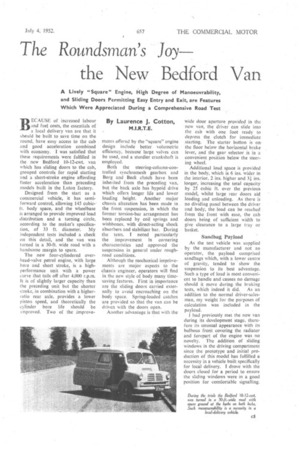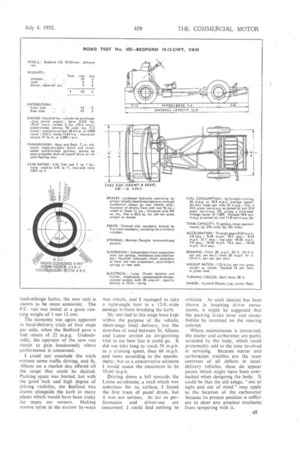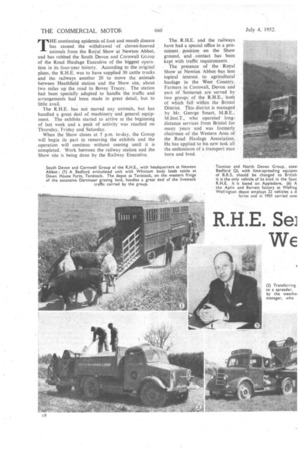The Roundsman' S J oy
Page 41

Page 42

Page 43

Page 44

If you've noticed an error in this article please click here to report it so we can fix it.
the New Bedford Van
A Lively "Square" Engine, High Degree of Manoeuvrability, and Sliding Doors Permitting Easy Entry and Exit, are Features Which Were Appreciated During a Comprehensive Road Test
By Laurence J. Cotton, M.I.R.T.E. BECAUSE of increased labour and fuel costs, the essentials of a local delivery van are that it should be built to save time on the round, have easy access to the cab and good acceleration combined with economy. I was satisfied that these requirements were fulfilled in the new Bedford 10-12-cwt. van which has sliding doors to the cab, grouped controls for rapid starting and a short-stroke engine affording faster acceleration than preceding models built in the Luton factory.
Designed from the start as a commercial vehicle, it has semiforward control, allowing 145 cubicft. body space, and the wheelbase is arranged to provide improved load distribution and a turning circle, according to the maker's specification, of 33 ft. diameter. My independent tests included a check on this detail, and the van was turned in a 30-ft. wide road with a handsome margin to spare.
The new four-cylindered overhead-valve petrol engine, with large bore and short stroke, is a highperformance unit with a power curve that tails off after 4,000 r,p.m. It is of slightly larger capacity than the preceding unit but the shorter stroke, in combination with a higherratio rear axle, provides a lower piston speed, and theoretically the cylinder bore life should be improved. Two of the improve merits offered by the "square" engine design include better volumetric efficiency, because large valves can be used, and a sturdier crankshaft is employed.
Both the steering-column-controlled synchromesh gearbox and Borg and Beck clutch have been inherited from the preceding van, but. the back axle has hypoid drive which offers longer life and lower loading height. Another major chassis alteration has been made in the front suspension, in which the former torsion-bar arrangement has been replaced by coil springs and wishbones, with direct-acting shock absorbers and stabilizer bar. During the tests, I noted particularly the improvement in cornering characteristics and approved the suspension in general tinder roughroad conditions.
Although the mechanical imprbvements are major aspects to the chassis engineer, operators will find in the new style of body many timesaving features, First in importance are the sliding doors carried externally to avoid encroaching on the body space. Spring-loaded catches are provided so that the van can be driven with the doors open.
Another advantage is that with the wide door aperture provided in the new van, the driver can slide into the cab with one foot ready to depress the clutch for immediate mailing. The starter button is on the floor below the horizontal brake lever, and the gear selector is in a convenient position below the steering wheel.
Additional load space is provided in the body, which is 6 ins, wider in the interior, 2 ins, higher and 3i ins.
longer, increasing the total capacity by 25 cubic ft. over the previous model, whilst large rear doors aid loading and unloading. As there is no dividing panel between the driver and body, the load can be reached from the front with ease, the cab doors being of sufficient width to give clearance to a large tray or basket.
Sandbag Payload
As the test vehicle was supplied by the manufacturer and not an operator, the payload comprised sandbags which, with a lower centre of gravity, tended to show the suspension to its best advantage. Such a type of load is most convenient to handle and causes no damage should it move during, the braking tests, which indeed it did. As an addition to the normal driver-salesman, my weight for the purposes of calculation was included in the payload. . .
1 had previously met the new van during its development stage, therefore its unusual appearance with its bulbous front covering the radiator and forepart of the engine was no novelty. The addition of sliding windows in the driving compartment since the prototype and initial production of this model has fulfilled a necessity in a vehicle built specifically for local delivery. I drove with the doors closed for a period to ensure the sliding windows were in a good position for comfortable signalling. Having appraised this innovation, and the day being warm and dry, the doors were opened for the remainder of the trials as they would undoubtedly be in normal service. In 75 miles use of the van, I could find no purpose for the built-in ventilators which r supply cool air below the instrument panel while the vehicle is in motion. For localdelivery service, where the driver is in the van for brief periods when travelling between calls, the ventilator system does appear a luxury. The driver will mostly leave the doors open and in cold weather the ventilators will undoubtedly be closed. I appreciate such provision on a long-distance vehicle with semior full-forward control.
I tried the accessibility of the cab and, although rather over average height and leg length, I found a simple drill for sliding into and out of the driving seat without wasting a fraction of a second. The seat was pushed back as far as the adjuster would permit, and apart from reaching down to release the handbrake or press the starter button, all other controls were comfortably reached.
Seating Position With the seat part way forward, which was not comfortable for my leg length. there was insufficient room for the feet between the wheelbox and seat, but presumably a short driver would swing his legs clear of the wheelbox when entering or leaving. The steering wheel is ideal in height because although it does not restrict forward visibility there is ample room for the knees when entering or leaving the cab.
Steering column gear change control is a labour-saving detail of some importance when considered over a day's work which might involve 60-100 calls. I also approve of a three-speed gearbox for the local-delivery vehicle because of its simplicity and utility. The designer of the Bedford van has wisely arranged the engine to be offset in the chassis to afford more foot space between the engine cowling and wheelbox. There is adequate room for foot movement and with the spacing of pedals there is no danger of overlapping the accelerator and brake.
I consider the water thermometer included in the Bedford instruments another luxury when applied to a short-distance van and would prefer c6 to see an ammeter or oil gauge in its place. The two-spoke car-type steering wheel gives a clear view of the instruments and completes the handsome effect afforded to the driving compartment. The removable section of the engine cowl projecting into the cab is set in rubber forming a seal, and from experience it is effective in keeping out draughts and reducing engine noise level.
On the weighbridge the total and distributed load checks revealed the advantage of bringing the weight towards the front by semi-forward control. Perhaps my weight in the cab made a slight difference to the distribution but, referring to the data panel, 43 per cent. of the total load was supported by the front wheels and 57 per cent. by the rear axle. The tyre equipment is adequate for the load carried, which is unusual in most light-delivery vehicles.
After leaving the weighbridge, the .van was driven to the Vauxhall Motors private test track at Welwyn where the front suspension was tried over the bump circuit. It survived this test and kept a straight course at 18-25 m.p.h. in which the critical speed of suspension periodicity occurs.
The vehicle supplied for my trials had nearly 5,000 miles to its 'credit, including a period on the M.I.R.A. Lindley course, and was one of the first production batch but with sliding windows fitted as a modification. In spite of two miles of harsh treatment over the bumps there was never a trace of panel drum or door rattle.
From Welwyn, I drove to the North Orbital road, the customary testing site for Luton-built vehicles, to measure the acceleration and brake performance. First came the braking tests, using the air pistol to mark the point of initial pressure of the pedal. I found the braking as near perfect as possible, there being a slight tendency to pull to the near._ side with the camber of the road and whilst all the tyres left a heavy' mark on the road, the wheels did. not lock.
Stopping distances of 20 ft. from 20 m.p.h. and 47 ft. from 30 m.p.h. obtained, are a fair indication of good retardation approaching wheel' locking. During previous driving,. with occasional sharp brake applications, the sliding doors remained open, but during the . emergency tests they did occasionally over-ride the spring-loaded catches. I would advocate a positive lock to hold the doors open as a safeguard under all conditions.' Tapley meter readings during emergency stops registered 85-92 per cent. efficiency at 20 m.p.h.
Faster Acceleration When testing the former Bedford 10-12-cwt. van, I praised its acceleration rate but the new short-stroke engine gives even faster acceleration despite using an axle of higher ratio. From a standing start, the latest version reached 30 m.p.h. in 10.7 secs. and 40 m.p.h. in 21.1 secs., which is 2.2 secs. faster than its predecessor. The combination of high-ratio axle and maximum torque at 2,000 r.p.m., instead of 1,800 r.p.m., has made a slight difference to the top-gear acceleration, 19.2 secs. elapsing between 10-30 m.p.h. against 16.6 secs for the P.C. van.
Consumption trials were made over the customary route which includes climbing Welwyn Hill on the outward journey. There were two slight traffic hindrances during the 18-mile circuit, and slightly more fuel was used on the outward leg. The fuel return of 36 mpg. at 30.9 m.p.h. average speed for continuous operation is an excellent standard of economy. In the previous trials with the P.C. van, a consumption rate of 39.2 m.p.g. was obtained at 28.8 m.p.h., but developed to the time
load-mileage factor, the new unit is shown to be more,econornic. The P.C. van was tested at a gross running weight of 1 ton 12 cwt.
The economy was again apparent in local-delivery trials of four stops per mile, when the Bedford gave a fuel return of 22 m.p.g. Undoubtedly, the operator of the new van stands to gain handsomely where performance is concerned.
I could not conclude the trials wimout some traffic driving, and St.. Albans on a market day, offered all the scope that could be desired. Parking space was limited, but with the good lock and high degree of driving visibility, the Bedford was drawn alongside the kerb in many places which would have been tricky for many car, owners. Making reverse turns in the narrow by-ways
Was simple, and I managed to take a right-angle turn in a 12-ft.-wide passage without brushing the kerb.
My test had to this Stage been kept within the purpose of the vehicle, short-stage local delivery, but the stretches of road between St. Albans andLuton invited an invigorating trial to see how fast it could go. It did not take long to reach 50 m.p.h. as a cruising speed, then 60 m.p.h. and more according to the speedometer, but as a conservative estimate I would assess the maximum to be 55-60 m.p.h.
Driving down a hill towards the Luton aerodrome, a road which was notorious for its surface, I found the first trace of panel drum, but it was not serious, As far as performance and driver-use are concerned, 1 could find nothing to Criticize. As such interest has been shown in lessening driver movements, it might be suggested that the parking brake lever and starter button be mounted on the steering column.
Where maintenance is concerned, the starter and carburetter arc partly screened by the body, which could presumably add to the time involved in servicing. Because starter and carburation troubles are the most common of all defects in localdelivery vehicles, these do appear points which might have been overlooked when designing the body. It could be that the old adage, "out of sight and out of mind" may apply to the location of the carburetter because its present position is sufficient to deter any amateur mechanic from tampering with it.
THE continuing epidemic of foot and mouth disease has caused the withdrawal of cloven-hooved animals from the Royal Show at Newton Abbot, and has robbed the South Devon and Cornwall Group of the Road Haulage Executive of the biggest opera. tion in its four-year history. According to the original plans, the R.H.E. was to have supplied 30 cattle trucks and the railways another 20 to move the animals between Heathfield station and the Show site, about two miles up the road to Bovey Tracey. The station had been specially adapted to handle the traffic and arrangements had been made in great detail, but to
little avail. , The R.H.E. has not moved any animals, but has handled a great deal of machinery and general equipment. The exhibits started to arrive at the beginning of last week and a peak of activity was reached on Thursday, Friday and Saturday.
When the Show closes at 5 p.m. to-day, the Group will begin its part in removing the exhibits and the operation will continue without ceasing until it is completed. Work between the railway station and the Show site is being done by the Railway Executive. The R.H.E. and the railways have had a special office in a prominent position on the Show ground, and contact has been kept with traffic requirements.
The presence of the Royal Show at Newton Abbot has lent topical interest to agricultural haulage in the West Country. Farmers in Cornwall, Devon and part of Somerset are served by two groups of the R.H.E., both of which fall within the Bristol District. This district is managed by Mr. George Smart, M.B.E., M.Inst.T., who operated• longdistance services from Bristol for many years and was formerly chairman of the Western Area of the Road Haulage Association. He has applied to his new task all the enthusiasm of a transport man born and bred.
























































































